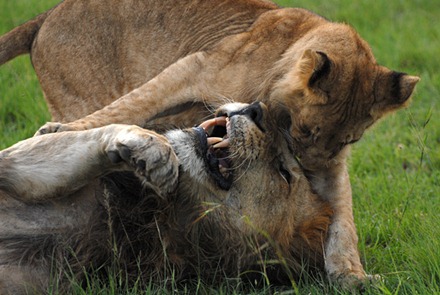After some more investigation around the Musiara Marsh, I can sadly confirm that Lispy is no longer alive. It has been difficult tracking down all the member of the Marsh Pride, including all the youngsters, but all are now accounted for except Lispy.
On a training session with the guides from
Serian Camp, I found
Joy from the Three Graces eyeing a herd of impala within the Mara River treeline. She looked thin, and had better step up her hunting – she now has four three-month old cubs to look after, discovered by Nicholas Ratia, our reporting guide from
Karen Blixen Camp. With the Marsh Pride clocking up over 20 lions in total – including many boisterous male teenagers – It’s no wonder she’s keeping her little ones at a distance. Matajo and Hasani, her older cubs, are now spending more and more time on their own, but have been welcomed by the main group. They’re certainly too young to be looking after themselves.

Joy with two of her little ones – thanks to Nicholas for a great picture!
Next, we found the majority of the pride resting near the Musiara Marsh Windmill. We counted 15 lions in total – including
Clawed and
Romeo, the pride males. Clawed is really showing his age, and I don’t know how long this pair can hold their pride. I identified Charm, resting with her three large cubs, one intent on annoying Romeo, who wasn’t best pleased with his play-mate.

This cub had better watch out!
Siena, the third of the Three Graces, was sleeping within the group. Once a clear splinter group, it certainly appears that the trio have been formally accepter back in to the main pride. This is probably somewhat down to the loss of Red earlier last year, and now Lispy – with a large number of demanding cubs and youngsters, there are many mouths to feed. Certainly, many of the pride appeared rather thin.
White Eye and Bibi, the two remaining original Marsh Pride females, were the last adults to be identified by the Serian Camp guides. Jonathan Koikai quickly pointed out the unmistakable female with her missing eye.

White Eye (left), Charm (centre) and Siena (right) are now the pride leaders, together with Bibi (below)
Finally, we tracked down the young females that are Bibi, Lispy, Red and White-Eye’s older cubs. Still youngsters, the four girls were playing with two tortoises that they had found. Although lions can eat everything from mice to elephants, these hard cased critters proved too much for these inexperienced lionesses!

You might want to remove the outer packaging!
So it is now clear that we’ve lost Lispy. As a core female in the Marsh Pride for many years, it is certainly a loss. However, at the ripe age of 13, Lispy has been a successful mother for a decade, and has left behind some formidable descendants. With the reunion of the main pride and the Three Graces, I have little doubt that the Marsh Pride will continue to thrive as the best loved lions of the Masai Mara.

Lispy looks out over her territory of the Musiara Marsh
Sara


























































